Rolls-Royce Wraith Review: Driving a $400K Dream Machine
Mellifluous, yet powerful. Gracious, yet gutsy. An engineering and technical pleasure to drive, the 2015 Rolls-Royce Wraith is a truly unique vehicle.
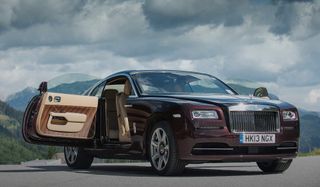

Mellifluous, yet powerful. Gracious, yet gutsy. An engineering and technical pleasure to drive, the 2015 Rolls-Royce Wraith is a truly unique vehicle. And so it ought to be. My test Wraith listed for $398,350. Let's just call it an even $400K.
Such stratospheric prices might sound supercilious, but these cars are not merely about catering to the 1 percent. They are about creating the finest, state-of-the-art grand touring vehicles possible, using unfettered engineering and craftsmanship. And technology. Yes, the Wraith is frighteningly quick. Its massive 6.6-liter V-12 engine has oodles of power and torque. And, yes, it's more cosseting than a baby's blanket. But the Rolls-Royce Wraith also uses technology, like lane-departure warnings, front, rear and top cameras, and the latest mapping data, to deliver what in a certain vernacular would be called a tasty ride.
The Tech
The Wraith envelopes the driver (and passengers) in hand-stitched leather, bespoke controls, and an overall interior so luscious with deep, downy carpeting, oak paneling and star-studded ceiling of fiber-optic lights that it lulls one into a sense of serenity. Just sitting in traffic is a joyful experience. Who needs meditation when you've got a Rolls?
But beneath the unmitigated luxury, the Wraith has some unique technology, specifically the ability to read topographic information about the road ahead and automatically adjust the transmission and shifting of the car. Using the GPS system, this luxury vehicle can anticipate hills, for example, and make adjustments to maintain your speed — without the driver being aware of the intervention. It works whether you're under the built-in navigation system's guidance or not.
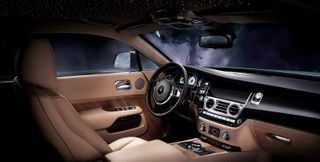
To put the satellite-assisted transmission to the test, I took the Wraith touring for a few days in the mountains of Vermont. The first major ascent proved the transmission system's worth. Climbing a mountainside that puts tractor-trailers into a crawl and makes every other car lurch as it frantically downshifts, the Wraith maintained its speed without huffing or puffing, seamlessly anticipating the steep grade and bringing power up accordingly.
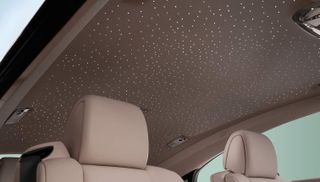
Of course, having 12 cylinders to draw upon doesn't hurt, but I found the system to be remarkably accurate in gauging both ascents and descents on a wide variety of roads — back country and interstates alike. The technology was originally developed to aid fuel efficiency, particularly for long-haul trucks, but when applied to the Rolls-Royce it supports the design philosophy that the ride should be fluid and effortless. In other words, what you'll notice is that you don't notice any sudden downshifts or hiccups over hill and dale.
MORE: Android Auto FAQ: Everything You Need to Know
Sign up to get the BEST of Tom’s Guide direct to your inbox.
Upgrade your life with a daily dose of the biggest tech news, lifestyle hacks and our curated analysis. Be the first to know about cutting-edge gadgets and the hottest deals.
Overall, however, Rolls-Royce has not adopted a cutting-edge approach to technology. The company has cherry-picked features that work while remaining understated. Rear, side- and top-view cameras can be switched on the screen at any time to give you those views, but they are there mainly to cover your blind spots (as well as prevent you from dinging the two-tone paint).
Another example is the Rolls-Royce Control Center in-dash system, which is based on parent company BMW's iDrive (although at least one iteration behind). RR has added many of its own finishing touches, of course, including hiding the whole display behind a powered louver when discretion is advised.
Using GPS, this Rolls can anticipate hills and make adjustments to maintain your speed.
The system does not use a touch screen. Instead, the primary control is a large dial on the center armrest that you turn, press and toggle to move between menu options. Several buttons for radio, CD and the main menu orbit the dial.

Is this the best interface? I've worked through several versions of BMW's iDrive, and I still find it wanting in many respects (although the latest version in the BMW 7 Series with a touch screen and gesture recognition is a marked improvement). For example, voice commands will take you through contacts on a connected phone, but if you want to call a new number, you have to use the dial to rotate through a rotary display of numbers on screen, clicking on each one to select it. The system allows you to do this while driving — something I don't recommend.
Voice interaction is augmented with British-accented female vocals, but she doesn't understand everything you say. On the positive side, the navigation system is smoother than most. You don't have to go through multiple steps to enter an address verbally, just spit the whole address out at once and the system recognizes where you want to go. Most of the time, the Emma Peel voice politely instructs you to make a turn or tells you it's "processing input," but there are the occasional details that are spoken in a courser American female's voice.
MORE: Top 10 Teched-Out Cars
On the negative side, some functions remain available in hard-button controls only, such as temperature adjustment, but at least the Rolls-Royce voice-recognition system responds to "make driver temperature 72 degrees" by telling you the function is "currently unavailable."
The rest of the controls in the car are special in as much as they don't flaunt their technological underpinnings. There are those inimitable British touches, such as labeling the trunk-release button "Boot." There are power-assist buttons for the big, backward-opening doors that close with a hush, and the door-storage bins have built-in motion sensors that trigger lights to illuminate the pockets when you reach down into them. The driver's display has analog dials, and a Power Reserve percentage dial: It's not an indication of RPM or electrical charge but rather an indication of how much, well, power is available for overtaking or roaring up a mountain highway.
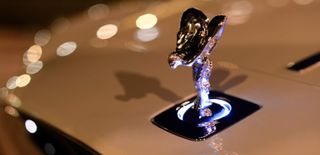
You can swing your foot under the rear bumper to open the boot hands-free (hey, the feature is also available on Fords), and retract the Spirit of Ecstasy hood ornament automatically (not available on Fords). One particularly smart feature: When the car detects that the exterior temperature is 37 degrees or lower, a signal sounds and a snowflake appears on the heads-up display to tell you there's an increased risk of ice on the road — a reminder I found handy one frosty morning.
The 600-watt Rolls-Royce bespoke audio system is limpid and lithe, handling everything from Pink Floyd to Thelonious Monk with equanimity. It not only has a 20.5 GB hard drive, but also a CD player (Yeah!). Even the stereo system's satellite radio proved better than others I've tested. In places where dozens of other vehicles' Sirius XM service dropped out, the Wraith's radio buffering kept it playing, as smooth as the ride.
The Drive
The Wraith is a trip to the moon on gossamer wings — if those wings could generate 624 horsepower and get you from 0 to 60 in 4.4 seconds. What's truly impressive, though, is the power available under full highway speed. About to be overtaken by a rapidly approaching Audi A8? A press of the accelerator will leave the Audi behind as if it were standing still.
Just sitting in traffic is a joyful experience. Who needs meditation when you've got a Rolls?
And there is simply nothing like the ride of a Rolls-Royce. Often described as a floating, magic- carpet ride, it is more than that. Wending through parkway traffic on an ocher and crimson autumn afternoon, I found the Wraith a totally seamless experience. When you put your foot down, there's a pleasing throaty sound from the car; not enough to disturb your enjoyment of the scenery, but enough to alert drivers around you to give you some breathing room.
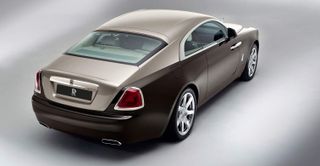
For all the performance, the Wraith is not a sports car. Under hard braking, you're reminded of how heavy this elegant beast is as it pitches forward. The suspension can feel a little disconnected from the road until you push it into corners and elicit the predictable understeer. Then the active steering tightens up, and again lightens up when you drive less aggressively.
Most impressive, on a particular bridge damaged by frost heaves and not repaired for more than a decade, every car or truck I've ever tested on that particular stretch jumps erratically — but not the Wraith. As I watched cars ahead bounce frenetically on the bad section of road, the Wraith glided over it in total control: it wouldn't have woken a sleeping baby in the back seat.
MORE: Connected Cars: A Guide to New Vehicle Technology
Lane-departure warnings are conveyed via small vibrations in the steering wheel, like virtual rumble strips, and the adaptive cruise control is the smoothest, most seamless system of its type I have ever tested. (Yes, even smoother than the Volvo XC90.) It will automatically stop the car in traffic and then if the traffic begins to move within a few seconds, automatically start following the cars ahead again. My only criticism is that, if anything, the adaptive system is too cautious, pausing longer than necessary after a slower car has moved out of the lane ahead before accelerating again.
Drive It or Park It?
You meet a lot of people when you drive a Rolls. Moms circle it in grocery store parking lots. Drivers double back to take pictures. The guys at the gym gawk. Everyone wants to know: What's it like to ride in it?
It is superlative in every meaning of the word. It's a highway monster, it's a parkway princess. It won't beat top-notch sports cars on a slalom course by a long shot, but when you just want to pull away from the pack, it is without peer. Did I miss the fact that CarPlay and Android Auto aren't included? Not one bit.

Rolls-Royce produces only about 4,000 cars each year (compare that to Toyota, which built nearly 2 million vehicles in North America alone last year). And it's all about customization; you can have yours bathed in one of more than 44,000 colors (or give the builders a swatch to match). Ultimately, given the tight supply and the illustrious engineering, the price somehow seems worth it. So for those who can afford it, your carriage awaits.
2015 Rolls-Royce Wraith: The Vitals
Price as Tested: $398,350 MSRP
Engine and Drive Train: 6.6-liter, 12-cyclinder engine with 8-speed automatic transmission and rear-wheel drive.
Fuel Rating: 13 mpg city/21 mpg highway; 15 mpg combined
Connected Car System: 10.25-inch LCD-based RR in-dash system.
Safety Technologies: Lane-departure warning; adaptive headlights.
Driver-Assist Technologies: Adaptive cruise control with automatic braking and starting; parking assistance front- and rear-camera views; satellite-assisted transmission.
Installed Options: Heads-up display, Starlight Headliner, lambs-wool foot mats.
John R. Quain has been reviewing and testing video and audio equipment for more than 20 years. For Tom's Guide, he has reviewed televisions, HDTV antennas, electric bikes, electric cars, as well as other outdoor equipment. He is currently a contributor to The New York Times and the CBS News television program.
Most Popular



